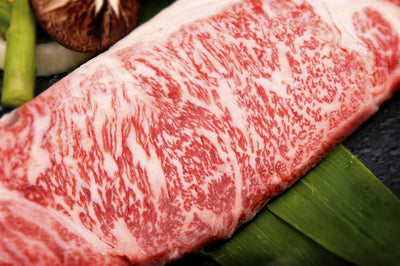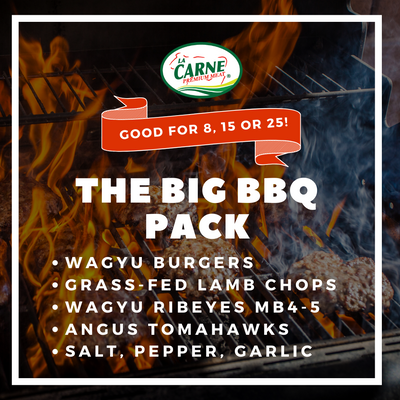Will it be tender though?

Yes, you can put a seasoned ribeye or tenderloin steak on a grill and have a lovely steak night. But have you ever experienced your steak being hard to chew, or slightly drier than you imagined? Can you do the same method as well with brisket, flank or skirt steak and get a soft and juicy result?
For many years I struggled with getting my steak and other meat cuts the way I envisioned in my mind- juicy, flavorful and tender. Now I can say I make steaks excellently after much trial and error and a few points to remember, which I share below! (For information on some steak terms that are not familiar, click here for our steak dictionary)
1. Is it marbled, or lean?
The less marbling (intramuscular fat) in the steak, the easier it is to overcook your steak and make it tough as leather. Marbling moistens meat as it cooks. Therefore if you are cooking a lean cut, only cook until medium otherwise it will be super tough. Another option is to cook it sous vide and then quickly sear after cooking to retain moisture in the meat. With marbled meat, you can relax a little more as it's less likely to dry out. Our personal opinion is it's still best to cook any steak rare-medium to get the full melt-in-the-mouth experience of a food marbled steak.

Lean Tenderloin Medallions

Marbled Ribeye Steaks
2. Temperature before cooking
Never take your steak straight out of the fridge or freezer and put it straight on a hot pan. The muscles will contract immediately and render the steak tough as nails! Key is to leave your steaks at least 15-20 minutes on your kitchen counter so it becomes room temperature before adding seasoning and placing on a hot pan. You will see how the steak is more supple and soft.
3. Internal cooking temperature
The obvious point to discuss is also the internal cooking temperature of your steak which indicates when it's perfectly done to your desired doneness. Very easy to get a thermometer at any UAE kitchen supply shop such as Tavola, ACE Hardware, Think Kitchen and even supermarkets. Remember to stick the probe (end of the thermometer) into the center of the steak and not just the surface!
- Blue - 100% red center, internal temp. 10-29C. Should feel spongy with no resistance.
- Rare - 75% red center, internal temp. 30-51C. Should feel soft and spongy with slight resistance.
-
Medium Rare - 50% red center, internal temp. 57-63C. Should feel fairly soft and slightly springy.
- Medium - 25% red center, internal temp. 63-68C. Should feel fairly firm and springy.
- Medium Well (past the point of no return) - slight hint of pink, internal temp 72-77C. Should feel firm with a slight spring.
- Well Done (waste of a good quality steak) - 100% brown throughout, internal temp 77C+. Should feel very firm and will spring back quickly.
4. Is there a lot of connective tissue in your meat?
What is connective tissue anyway? It's the tissue holding muscles together in your favorite meat cuts. They usually look pale white or translucent. Some are not edible but others are incredible useful in making a dish melt-in-the-mouth wonderful such as in braised brisket. If they are inedible like the silverskin found on whole tenderloin, your butcher will usually clean or trim those.
The more connective tissue, the more the need to break that tissue down and make the meat soft and tender. You can achieve this by slow cooking or a great marinade. Throwing cuts with a lot of connective tissue straight on a hot grill will give you a very tough experience eating it.
Cuts with little or no connective tissue can be slightly seasoned and thrown directly on the grill. Examples are Ribeye, Striploin and Tenderloin.
Cuts with a lot of connective tissue must be slow cooked or marinaded for at least 30 minutes then grilled. Examples are Brisket, Flank and Skirt Steak.

(Above) Our favorite skirt steak grilled after marinading then served with a chimichurri sauce! Marinade your skirt steak with a simple marinade of garlic, apple cider vinegar, lime juice, orange juice, soy sauce and salt and pepper to get an amazingly juice result.

(Above) Slow-cooked brisket is one of life's most beautiful treasures. For tips on making a slow-cooked brisket for the first time at home click here.
5. Resting and Cutting across the grain
Resting meat is very important after cooking it, for more info refer to our Steak Dictionary here which explains more!
If you've read some of our other blogs you know how we feel about cutting across the grain! It's probably the most important because you are cutting across the fibres of the meat to make it the best possible eating experience for you! Never forget to cut across the grain!


So there you have it, the four points to ponder when maximizing meat tenderness!
- Meat marbling
- Temperature (Before cooking and internal cooking temp)
- Amount of Connective tissue
- Resting and cutting across the grain
Hope you enjoyed this week's blog and let us know your feedback, we'd love to hear from you!
- Joan, Culinary Business Manager
Sources:
- https://www.lakegenevacountrymeats.com/blog/announcements/all-about-lean-meats
- http://ifyoucantaffordtotip.com/steakguide/
- https://meat.tamu.edu/ansc-307-honors/meat-tenderness/


















buy cialis pills [url=https://tadalafilol.com/ ]tadalafil drug [/url] cialis cost where to get tadalafil tadalafil online with out prescription
buy cialis pills [url=https://tadalafilol.com/ ]tadalafil drug [/url] cialis cost where to get tadalafil tadalafil online with out prescription
buy cialis pills [url=https://tadalafilol.com/ ]tadalafil drug [/url] cialis cost where to get tadalafil tadalafil online with out prescription
buy combigan brimonidine generic
combigan 5 ml combigan eye drops generic
Leave a comment